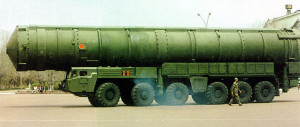

According to a US intelligence report leaked to the Washington Free Beacon, China has carried out a fourth flight test of the Dong Feng-31A (DF-31A) intercontinental ballistic missile (ICBM) last week, firing off a new road-mobile ICBM. The test took place at Wuzhai Space and Missile Test Center in the Shanxi province, about 267 miles southwest of Beijing. The missile flew westward to impact at a missile test range in western China. US intelligence monitored the test.
The test represents the fourth missile test conducted by China this summer. Thursday’s DF-31A test came 10 days after the flight test at Wuzhai of a silo-based CSS-4 Mod 2 long-range missile, and several weeks after flight tests of a new road-mobile DF-41 ICBM, on July 24, and a submarine-launched JL-2 missile on Aug. 16. According to US sources the extensive pace of tests indicates the growing maturity China’s arsenal of long range mobile ballistic missile, strengthening the country’s strategic offensive missile force.
China’s secretive military made no mention of any of the tests, except an official confirmation of the development DF-41 ICBM. While the DF-31A, as other Chinese ballistic missiles is a single-warhead weapon, the US intelligence believe the DF-41 will carry three to ten independently targetable warheads, each carrying a nuclear warhead, thus becoming the first Chinese missile to carry Multiple Independently targetable Reentry Vehicles (MIRV).
China is currently in the middle of a major strategic nuclear forces buildup that includes four new ICBMs – the DF-41, JL-2, DF-31A, and another road-mobile missile called the DF-31 that is assessed to have shorter range, compared to the DF-31A. This process includes fielding solid-fuelled missiles launched from mobile launchers, and dispersed through a 3,000 miles tunnel network, storing and protecting the missiles, launchers and spare reloads.
The DF-31A has been deployed since the mid-2000s and has an estimated range of 7,000 miles, enough to give China the capability to cover the entire Pacific Ocean, or hitting Washington or European capitals in a nuclear strike. The DF-31A warhead is likely to be maneuverable, thus capable of avoiding some ballistic-defenses.

Two weeks prior to the DF-31A test China tested the much larger DF-41 Intercontinental. On August 30 China’s Defense Ministry confirmed that the People’s Liberation Army (PLA) had conducted missile tests within national territory and clarified that they were not targeted at any one country. Spokesperson Geng Yansheng described the test as a ‘normal weapons tests within China’s territory’. “These tests have no specific targets and were not targeted at any specific countries,” Geng said, reiterating that the weaponry buildup is to answer the need to safeguard national security. China has consistently claimed it will not be the first to use nuclear weapons and that its nuclear forces are designed for a counterstrike against a nuclear attack on its territory.
The spokesman did not comment about the type of missile tested, but domestic and foreign media reports said that the PLA’s Second Artillery Force had successfully test-launched several missiles, including DF-41 intercontinental ballistic missile. This missile has a range of 14,000 kilometers; it is loaded with up to ten Multiple Independently targeted Reentry Vehicles (MIRV), each carrying a nuclear warhead. In addition to shorter-range ICBMs known as the DF-31 and DF-31A, which are believed to target India and Russia, the new ICBM is said by U.S. officials to be designed to hit U.S. targets with multiple nuclear warheads.
According to the Conservative Washington Free Beacon, the test of the DF-41 road-mobile ICBM occurred July 24 and has raising new concerns within the U.S. military and intelligence agencies over China’s long-range missile threat, according to officials familiar with reports of the test.
This strategic weapon provides China with a ‘first strike’ capability against the U.S. The test is also likely to renew debate within U.S. intelligence circles about whether China is seeking only a limited nuclear force, or is secretly building up its nuclear forces to challenge U.S. strategic power.
[wzslider info=”true”]
















